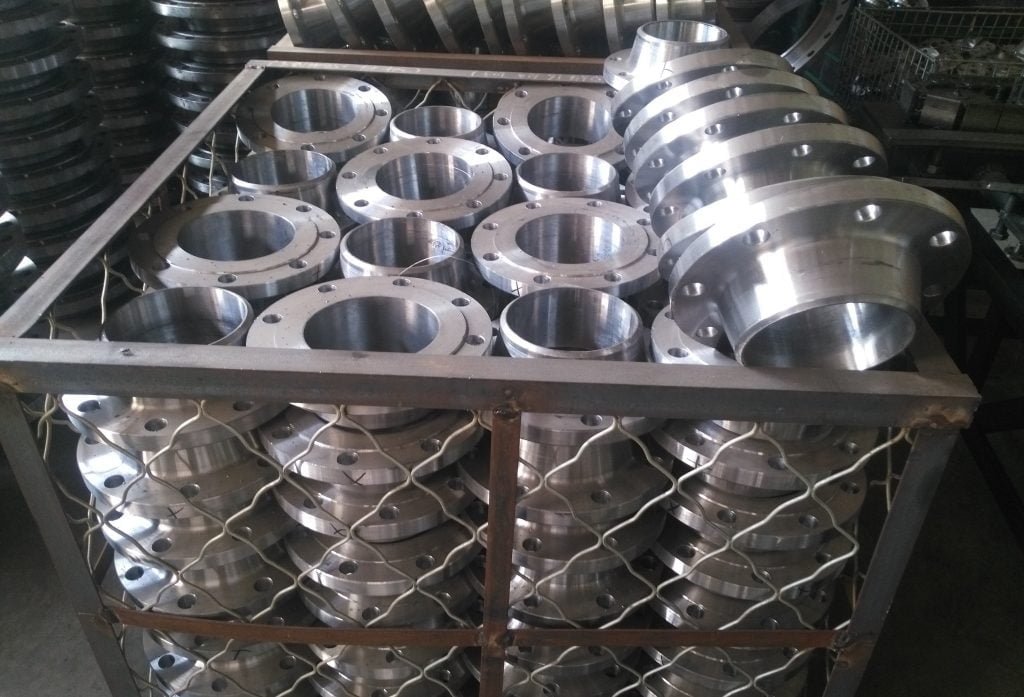Analysis of common flange marks
The dimensions of common pipe flanges vary depending on the standards followed. The most widely used standards include ANSI, ASME, and DIN. Here are some key dimensions typically found in these standards:

Flange Diameter (D)
Flange Diameter (D) refers to the outer diameter of the flange, which is measured from one side to the opposite side of the flange. It represents the overall size of the flange and plays a vital role in determining its compatibility with other components in the piping system.
The flange diameter is typically expressed either in inches for ANSI/ASME standards or in millimeters for DIN standards. The choice of measurement unit depends on the region and the specific standard being followed.
In ANSI/ASME standards, the flange diameter is often denoted using fractional or decimal inch measurements such as 1/2″, 3/4″, 1″, or 2.5″. These measurements are commonly used in North America and some other regions.
On the other hand, DIN standards, widely used in Europe and many other countries, express the flange diameter in millimeters. Common flange diameter sizes in DIN standards include 25 mm, 50 mm, 100 mm, and so on.
It is crucial to accurately determine the flange diameter during the design and installation of a piping system. This ensures proper alignment and connection of flanges with pipes, valves, and other components.
Flange Thickness (T)
Flange Thickness (T) refers to the measurement of the distance from the flange surface to the bottom of the flange rim. It indicates the thickness of the flange material and plays a critical role in ensuring the strength and stability of the flange connection.
The flange thickness is typically expressed in either inch for ANSI/ASME standards or millimeters for DIN standards, depending on the specific standard being followed.
In ANSI/ASME standards, the flange thickness is commonly denoted using decimal inch measurements. For example, it may be expressed as 0.5 inches, 0.75 inches, 1 inch, and so on. These measurements are widely used in North America and some other regions following the ANSI/ASME standards.
In DIN standards, which are widely adopted in Europe and many other countries, the flange thickness is typically expressed in millimeters. Common examples include 10 mm, 15 mm, 20 mm, etc.
Determining the appropriate flange thickness is essential for ensuring the durability and reliability of the flange joint. It must be carefully considered in relation to the operating conditions, pressure, and temperature of the piping system.

Bolt Circle Diameter (BC)
Bolt Circle Diameter (BC) refers to the diameter of the circle that passes through the center of each bolt hole on the flange. It is a key dimension that determines the spacing and alignment of the bolt holes for proper installation and secure connection of the flange.
The bolt circle diameter is typically expressed in either inch for ANSI/ASME standards or millimeters for DIN standards, depending on the specific standard being followed.
In ANSI/ASME standards, the bolt circle diameter is often denoted using fractional or decimal inch measurements. For example, it may be expressed as 4 inches, 8 inches, 12 inches, or 100 inches, indicating the distance between the centers of opposite bolt holes.
In DIN standards, which are commonly used in Europe and other regions, the bolt circle diameter is expressed in millimeters. Common examples include 100 mm, 200 mm, 300 mm, and so on, indicating the spacing between the bolt-hole centers.
Accurately determining the bolt circle diameter is crucial during the design and assembly of the flange connection. It ensures proper alignment of the bolts, facilitates the insertion of fasteners, and guarantees a tight and secure joint.
Number of Bolt Holes (N)
The number of Bolt Holes (N) refers to the total count of holes present on the flange that provide connection points for securing the flange to the pipe or equipment. These bolt holes are strategically placed around the flange to evenly distribute the load and ensure a secure and stable joint.
The number of bolt holes can vary depending on the size and type of flange. Commonly used flanges, such as ANSI/ASME and DIN flanges, typically have a specific pattern and arrangement for the bolt holes.
For example, ANSI/ASME flanges often have a bolt hole pattern that follows a symmetrical arrangement, such as 4, 8, or 12 bolt holes evenly spaced around the flange. This ensures balanced load distribution and facilitates easy installation.
In DIN flanges, the number of bolt holes may differ based on the specific size and class of the flange. Common examples include 4, 8, 16, or even more bolt holes, depending on the requirements of the application.
Determining the appropriate number of bolt holes is crucial for ensuring the integrity and stability of the flange connection. The number of bolt holes should be chosen to provide sufficient strength and rigidity based on the operating conditions, pressure, and temperature of the piping system.
At YANHAO, we offer flanges with varying numbers of bolt holes to accommodate different applications and standards. Our flanges are manufactured with precision and adherence to industry standards to provide reliable and secure connections in various industrial sectors.

Bolt Hole Diameter (BD)
Bolt Hole Diameter (BD) refers to the diameter of each individual bolt hole present on the flange. It is a critical dimension that determines the size of the bolts used to secure the flange to the pipe or equipment.
The bolt-hole diameter is typically expressed in either inch for ANSI/ASME standards or millimeters for DIN standards, depending on the specific standard being followed.
In ANSI/ASME standards, the bolt hole diameter is often denoted using fractional or decimal inch measurements. For example, it may be expressed as 1/2 inch, 3/4 inch, 1 inch, or 2 inches, indicating the width or diameter of each individual bolt hole.
In DIN standards, which are commonly used in Europe and other regions, the bolt-hole diameter is expressed in millimeters. Common examples include 20 mm, 25 mm, 32 mm, and so on, indicating the size of each bolt hole.
Accurately determining the bolt hole diameter is crucial for ensuring the correct size of the bolts that will be used to secure the flange. It ensures a proper fit and ensures proper load distribution and alignment during the flange assembly.
As a trusted manufacturer of pipe flanges, YANHAO provides a wide range of flanges with precise bolt-hole diameter measurements, adhering to both ANSI/ASME and DIN standards. Our flanges are designed to accommodate the appropriate bolt size, ensuring a secure and reliable connection in various industrial applications.

Note: The above dimensions are general guidelines, and specific sizes may vary depending on the flange type (e.g., slip-on, weld neck, blind) and the pressure class of the flange (e.g., 150#, 300#, 600#).
In conclusion, understanding the Bolt Circle Diameter, Number of Bolt Holes, and Bolt Hole Diameter is essential when it comes to ensuring secure and reliable flange connections. These parameters play a crucial role in maintaining the integrity and stability of the joint, preventing leaks and failures. By accurately determining and adhering to the appropriate measurements, piping systems, and equipment can be effectively connected, providing optimal performance and safety. Whether it’s ANSI/ASME or DIN standards, paying attention to these dimensions is vital for successful flange installation and operation. At YANHAO, we offer flanges that meet various standards and specifications, providing reliable and high-quality connection solutions for diverse industrial applications.
YANHAO, as a leading Chinese flange manufacturer, offers a wide range of flanges that meet various specifications and sizes, complying with ANSI/ASME and DIN standards. Our flanges are made of high-quality materials, ensuring accurate dimensions and adherence to industry standards. They are suitable for different industries, providing reliable and safe connections for various industrial sectors. If you are interested, please contact us via email.
Author: Lewis Liu
Hello, my name is Lewis Liu, and I’m a professional sales engineer with over a decade of expertise in the flange fittings sector.
I am quite informed about flange selection, installation, and maintenance. I am passionate about providing customers with the greatest solutions for keeping their pipeline systems running smoothly, safely, and dependably.
If you have any queries or concerns concerning flange fittings for your pipelines, whether they are about selection, material choice, specification requirements, or anything else, please contact me at any time. I am dedicated to providing expert advice and assistance to help you make educated decisions and reach your objectives.

